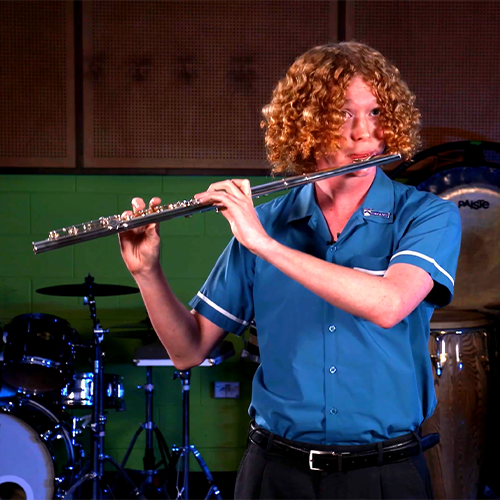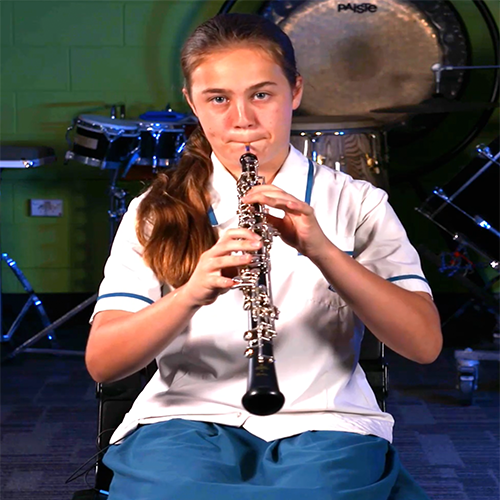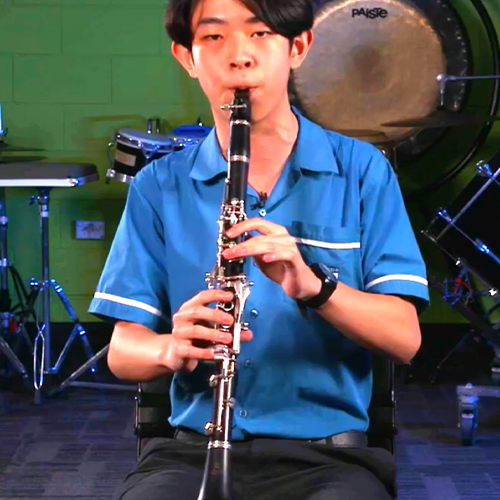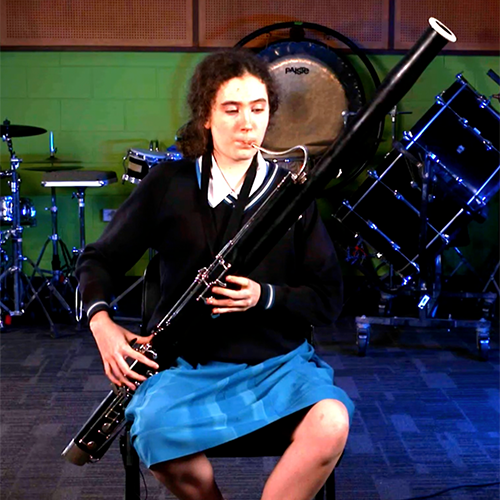Y2. Lesson 20. The woodwind family
Prior learning:None
Duration: 30 minutes
Materials:
Keywords: Beat, rhythm, singing, chanting, partners, rhymes, circle games.
Difficulty: ![]()
Prepare
Present
The woodwind family
Practise
 Melodic development
Melodic development
![]() Students sing the melody of target phrases from known songs.
Students sing the melody of target phrases from known songs.

- Explain to the class that you will sing a line from a song they know and they will sing back the next line using only solfa.
- Bounce High:
- T: Bounce high, bounce low
- Ss: so so la la so mi
- Goodnight:
- T: Good night, sleep tight
- Ss: so so mi mi so so mi
- Hot Cross Buns:
- T: Hot cross buns, hot cross buns
- Ss: do do do do do, re re re re, mi re do
- Naughty Pussy Cat
- T: Naughty pussy cat, you are very fat
- Ss: so so mi mi, la so mi mi, mi mi re do
 Rhythmic development
Rhythmic development
![]() Students clap and say the rhythm patterns to determine which song they are from.
Students clap and say the rhythm patterns to determine which song they are from.
- Students are seated and attentive.
- Project the graphic on the board.
- Explain that the class will discover the name of a song just by clapping its rhythm.
- Lead the class in clapping and saying the first rhythm pattern.
- Ask students for the name of the song. [Big black train]
- Repeat for the second line. [Bluebells]
- Repeat for the third line. [Candle burning bright]
- Repeat for the fourth line. [Here comes a magpie]
 Creative movement
Creative movement
![]() In this fun game, students sing and weave in and out of a circle.
In this fun game, students sing and weave in and out of a circle.
- Students form a circle with joined hands and are raised high to form arches.
- A chosen student weaves in and out of the arches as the class sings the song.
- On the words, 'Just choose me,' the chosen student chooses another student and joins hands.
- The pair then weave in and out of the circle, and the game repeats until no one is left.
 Listening
Listening
![]() Students discover the four main instruments of the woodwind family.
Students discover the four main instruments of the woodwind family.
- Project the graphics.
- Ask students what these four instruments are.
- Explain that the smallest instrument is called a flute, followed by increasing size of the oboe, clarinet and bassoon.
- Teach that these four instruments are part of the woodwind family in an orchestra.
- Discuss how the four instruments get bigger in size.
- Ask if students know why they are different sizes.
- Discuss if the size of the instrument would make a difference to the sound.
- Which instrument has the highest sound?
- Which instrument has the lowest sound?
- Ask what material each instrument is made from.
![]()
Play each short track from the audio player to demonstrate the sound each instrument makes.




 Visual learning
Visual learning
![]() Students discover more about the woodwind family.
Students discover more about the woodwind family.
![Flute [isolated] Flute [isolated]](https://young-maestro.com/wp-content/uploads/2023/09/Flute-isolated.png)
Flute
The flute is like a magical wand of music! It's a long, slender instrument you blow air into, making the most beautiful sounds.
Blowing gently into the tiny hole at the top creates melodies that can be soft and soothing or happy and lively. Flutes can be made from metal or wood, with shiny keys you press to change the notes.
Just like a bird singing in the forest, the flute can make you feel like you're flying through a musical adventure. So, if you ever get the chance to play or listen to a flute, be ready for a delightful musical journey full of enchanting tunes!
![Oboe [isolated] Oboe [isolated]](https://young-maestro.com/wp-content/uploads/2023/09/Oboe-isolated.png)
Oboe
The oboe is like the prince or princess of the music world! It's a special instrument with a long, elegant shape and a shiny, wooden body. To make music with it, you blow air into a tiny, reed-covered mouthpiece at the top, producing a unique, enchanting, bold and expressive sound.
The oboe can tell stories with its melodies, and it's often featured in fairy tales and adventurous music. When you hear it play, you might feel like you're on a magical quest, exploring hidden forests and meeting fantastical creatures. So, if you ever meet an oboe, listen closely; it will transport you to a world of musical wonder!
![Clarinet [isolated] Clarinet [isolated]](https://young-maestro.com/wp-content/uploads/2023/09/Clarinet-isolated.png)
Clarinet
The clarinet is like a musical magician's wand! It's a sleek, slender instrument made of wood or shiny plastic, and when you blow air into it, it creates the most delightful and playful sounds. Imagine the joyful tune of a circus or a friendly, chatty bird in the forest - that's the clarinet's magic!
It has lots of shiny keys that you press to change the notes and make all kinds of music, from happy tunes to sad melodies. The clarinet loves to tell stories through its music; when you listen, it's like going on an adventure filled with laughter and excitement. So, if you ever meet a clarinet, be ready to dance and play along with its beautiful melodies!
![Bassoon [isolated] Bassoon [isolated]](https://young-maestro.com/wp-content/uploads/2023/09/Bassoon-isolated.png)
Bassoon
The bassoon is like the friendly giant of the music world! It's a big, curvy instrument with a long, twisted tube and a magical double-reed mouthpiece. When you blow air into it, it creates deep and rich sounds that are like the hearty laughter of a kind giant.
The bassoon can play low and high notes, making it versatile and capable of telling all sorts of musical stories. Its unique sound can be funny, mysterious, or even a bit silly, like the comical character in a fairy tale. So, if you ever meet a bassoon, get ready to enjoy the whimsical and wonderful world of music it brings to life!
 Instruments
Instruments
![]() Students discover how to play Ickle Ockle on tuned percussion.
Students discover how to play Ickle Ockle on tuned percussion.
- Distribute tuned percussion instruments. In this exercise, xylophones are chosen.
- Divide the class into two groups.
- Demonstrate the melody of the first eight bars of the song to the first group.
- When secure, demonstrate the simple accompaniment to the second group.
- Conduct the two groups and monitor the class performance, offering gentle guidance where appropriate.

 Part work
Part work
![]() Students sing a known song in canon.
Students sing a known song in canon.
- Divide the class into two groups.
- Explain to the class that they will sing Bow Wow Wow with the first group beginning and the second group to start two beats.
- Conduct the first group to begin singing.
- After two beats, lead the second group to sing in canon.
- When secure, swap the two groups around.
 Assess
Assess
Suggested lessons
Y1. Beat II

Y1. Beat III

Y1. Beat IV

